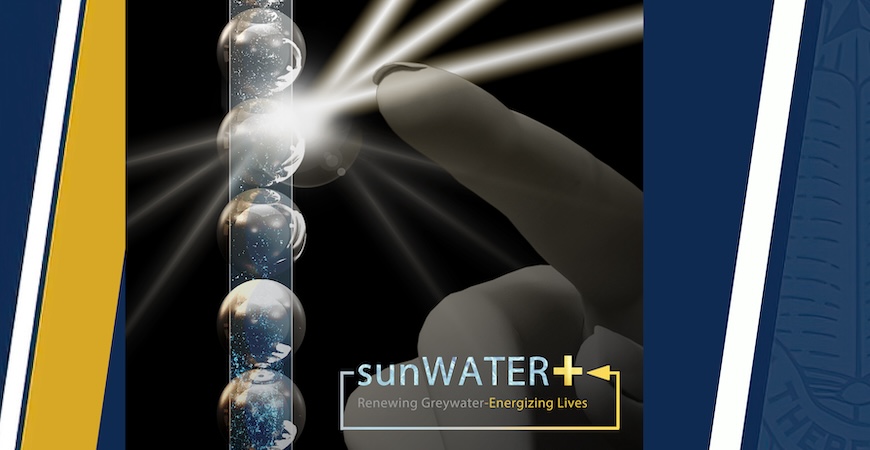
Almost 3 billion people worldwide are projected to suffer from severe water scarcity by 2025. Thousands have already been affected in California alone, where more than 1,200 wells ran dry in 2022.
It's never been more important to find ways to make the best use of this precious resource.
A project with co-principal investigators from UC Merced and two universities in Texas, led by a UC Berkeley professor, aims to significantly reduce residential water consumption by re-using much of that water before it is flushed into the sewer system.
With a $650,000 award from the National Science Foundation, architecture Professor Maria-Paz Gutierrez of UC Berkeley is leading research into diverting "greywater," or water from bathroom sinks and bathtubs, into toilet flushing and potential other uses such as laundry.
Gutierrez is working with UC Merced civil and environmental engineering Professor Marc Beutel and mechanical engineering Professor Gerardo Diaz, along with University of Houston civil engineering Professor Hongyi Li and construction engineering and project management Professor Kasey Faust of the University of Texas at Austin, Senior Personnel Professor Luke P. Lee from Harvard University and Professor Luisa Caldas from UC Berkeley.
"We're trying to address a key issue we face today - water scarcity," Gutierrez said. "The average family of four uses approximately 250 gallons of clean water per day, most of which goes to the sewer. More than half of that output is greywater."
Reusing that water has the potential to lower household or commercial water use significantly. The researchers propose a system that diverts greywater through a solar panel with microlenses coated with nanoparticles that interact with sunlight to kill microbes such as e coli and remove harmful chemical compounds. The process heats the greywater so it can be used as thermal energy as needed. Team members are also integrating AI in the solar photocatalytic panels with user interface capacities for building data trust and cultural sensitivities.
"We treat the water by exposing it to sunlight and consequently warming it up," Beutel said. The water then will be diverted to the toilet for use there.
"It isn't clean enough to drink but it's fine for flushing toilets or washing clothes," Gutierrez said.
It's important to treat the water first, because even though it's only going to be in the toilet and not for consumption, bacteria still can be dispersed when the toilet is flushed.
The project is designed for multiple purposes. Water heated by the sun during the day could circulate through the building to warm it when it's cold, Gutierrez said.
The project is one of 15 in the first stage of an NSF Convergence Accelerator 's Track K: Equitable Water Solutions. If the prototype is successful, the researchers could get a $5 million grant to implement their system.
Over the next nine months, each team will develop its initial idea into a proof of concept, identify new team members and partners, and participate in the NSF Convergence Accelerator's Phase 1 innovation curriculum, providing fundamentals in human-centered design; team science; use-inspired research; early-stage prototyping; and communications, storytelling and pitching. At the end of Phase 1, the teams will participate in a formal proposal and pitch to demonstrate the feasibility of their solutions and apply for Phase 2.
"Because water needs are complex, there isn't a one-size-fits-all solution," said Douglas Maughan, head of the NSF Convergence Accelerator program. "This topic is perfect for convergence - bringing multiple disciplines, expertise and sectors together - to solve large-scale challenges. We're excited to launch this track and to see how the 15 teams will engage and partner with communities, end-users and stakeholders to develop real-world sustainable solutions."
Those solutions have to function and be attainable.
"We have to not only make the technology but figure out how it's going to be implemented," Diaz said. "What would it take to implement technology like this?"
But in addition to making sure it works, the system also must be practical and cost-effective. And that twist has turned researchers into entrepreneurs.
"I'm doing research, I'm not a businessman," Beutel said. "But now I am developing a business model."
"An important aspect is the benefit to the community," Diaz said. "We are looking at the possibility of working together with a community that is having problems with water."
The group's research is interdisciplinary, incorporating architecture, chemistry, engineering, bioengineering, computing and social sciences. Teams collaborate with communities, California tribes, state government agencies and possibly businesses to implement their projects.
"The NSF is really trying to find groundbreaking approaches to solve water and equity challenges at the necessary accelerated pace of innovation," Gutierrez said. "We are trying to create affordable, sustainable technologies that can transform water and equity at the regional and national scales."